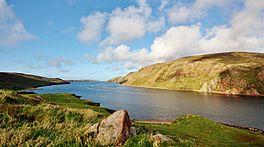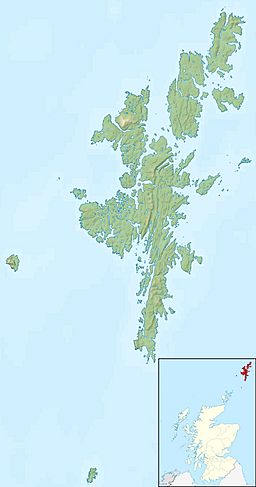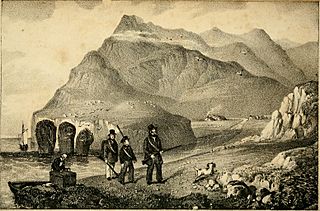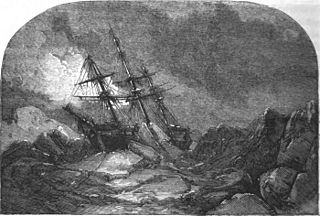Ronas Voe facts for kids
Quick facts for kids Ronas Voe |
|
|---|---|

Ronas Voe from above the abandoned Timna crofthouse.
|
|
| Location | Northmavine, Shetland |
| Coordinates | 60°31′15″N 1°28′44″W / 60.52083°N 1.47889°W |
| Type | Voe |
| Native name | Rønies Voe (Scots) |
| Ocean/sea sources | Atlantic |
| Max. length | 10.0 km (6.2 mi) |
| Max. width | 3.1 km (1.9 mi) |
| Max. depth | 42 m (138 ft) |
| Islands | 0 islands, several sea stacks |
Ronas Voe (Shaetlan: Rønies Voe) is a long, narrow inlet of the sea, also known as a voe, located in Northmavine, Shetland. It separates the land between Ronas Hill, which is Shetland's tallest mountain, and the Tingon peninsula. Ronas Voe is the second largest voe in Shetland, with Sullom Voe being the biggest. Small towns like Heylor, Voe, and Swinister are found along its shores. The town of Assater is also very close by.
Contents
What's in a Name?
Ronas Voe gets its name from Ronas Hill, which is right next to it. The word "voe" is a local Shetland word for a narrow inlet of the sea, similar to a fjord.
The name Ronas Hill has a few possible origins. Some think it comes from an old Norse word meaning "redness," referring to the red granite rock found in the area. Others believe it comes from an old Norse word meaning "a rough or rocky place." The spelling "Ronas" was chosen by mapmakers in 1881 and is now the most common way to write it.
In the past, Ronas Hill and Ronas Voe were spelled in many different ways before English spelling became more standard. Sometimes, Dutch sailors called Ronas Hill the "Blue Mountain" because it looked blue from far away.
Exploring Ronas Voe's Geography
Ronas Voe is sometimes called Shetland's "only true fjord". The tall cliffs around Ronas Voe were formed by ancient glaciers that carved through the land. These glaciers smoothed one side of the rock and left the other side rough.
In August 2014, heavy rain caused a landslide that temporarily blocked part of the road in Heylor.
Beaches of Ronas Voe
There are many beaches along the shores of Ronas Voe. One of them is the Lang Ayre, which is the longest beach in Shetland. Another beach, called The Blade, is a nesting spot for Arctic terns during the summer months.
List of Beaches
Here are some of the beaches around the voe, listed clockwise:
- Lang Ayre
- Slocka
- The Shun
- Ayre of Teogs
- Orr Wick
- Hollander's Ayre
- The Blade
- Sanda Cailla
- Ships Ayre
- Sannions Ayre
A Look at Ronas Voe's History
The Battle of Ronas Voe
On March 14, 1674, Ronas Voe was the location of a sea battle. A Dutch ship called the Wapen van Rotterdam was captured by three English Royal Navy ships: HMS Cambridge, HMS Newcastle, and HMS Crown. After this event, Captain Richard Carter of the Crown described Ronas Voe as "a very good and sound harbor for 500 Sayle of Shipps."
Robert Dunn's Adventures
In 1831, a bird expert named Robert Dunn visited Shetland to collect bird specimens. He wrote about his trip in a guide for others interested in nature. Dunn spent a lot of time in Assater, exploring Ronas Voe and Ronas Hill.
One time, he was caught in a big storm while returning to Ronas Voe. The wind and waves were very strong, and his boat was in danger. He and the boatmen had to work hard to get back to safety. They found a brief shelter behind a large rock, bailed out the boat, and then made a "desperate effort" to row against the wind and tide. They finally made it back to the voe, tired but safe.
Another bird expert, William Chapman Hewitson, visited Ronas Hill in 1832. He was disappointed to find very few Skua Gulls, which were once common there. He heard that Robert Dunn had collected many of these rare birds the year before. Dunn, however, said he didn't take so many as to harm the bird population. He believed that other visitors and even officers from a ship stationed in Ronas Voe had also shot many birds.
The Whaleship Diana
In 1866, a whaling ship called the Diana from Hull went on a trip to find whales and seals. It got stuck in ice for many months between Greenland and Canada. The crew didn't have enough supplies, and many became very sick with scurvy and exhaustion.
On April 2, 1867, the Diana finally broke free and arrived in Ronas Voe. Eight crew members had died, and only two were strong enough to call for help. Local men came aboard to help pump water out of the ship, as it was leaking. More crew members died in the days that followed.
The local people in Ronas Voe were incredibly kind and helpful. They brought food, helped with repairs, and provided coal to warm the ship. One crew member said, "The people in the neighbourhood were uncommonly kind: I never met with so much attention in all my life." After a week, the Diana left Ronas Voe and continued its journey.
Fishing in Ronas Voe
Ronas Voe was a place where people went fishing for a long time. In the past, during the "Haaf era," a few boats operated from a fishing station there.
Later, Ronas Voe became very busy during the "herring boom," when there was a lot of herring fishing. Many companies from places like Peterhead and Fraserburgh came to Ronas Voe to process herring.
Whaling Stations
At the start of the 1900s, two Norwegian whaling stations were built in Ronas Voe: the Zetland Whale Fishing Company and the Norrona Whale Fishing Company. They operated from 1903 to 1914. While these stations created some jobs for locals, people complained about the bad smell and pollution from processing the whales. Fishermen also worried that whale waste in the sea attracted sharks, scaring away the herring.
Jenny Gilbertson's Films
Jenny Gilbertson was one of the first female documentary filmmakers in the world. Four of her early films were shot in Ronas Voe, often featuring the Clark family and their traditional farm, called a croft. Two of her longer films, A crofter's life in Shetland and The rugged island; a Shetland lyric, include scenes from Ronas Voe. Two shorter films, Scenes from a Shetland croft life and In sheep's clothing, were filmed entirely in Ronas Voe.
For her film The rugged island, an old, empty croft house called Timna was fixed up for filming. It was not meant to be lived in again after the movie was made.
Modern Uses of Ronas Voe
Aquaculture
As of 2019, Ronas Voe has six offshore aquaculture sites. These include two salmon farms run by Scottish Sea Farms and four mussel farms run by Blueshell Mussels. There is also a crab factory at Skeo Head, which is now part of Blueshell Mussels.
Other Activities
Ronas Voe is often used by the Coastguard Search & Rescue helicopter for practice drills. They often land at the nearby Loch of Shun.
Ronas Voe is also a popular spot for canoeing and kayaking. People enjoy its calm waters, impressive cliffs, and the many sea caves along the west coast.
Ronas Voe in Culture
"Ronas Voe" is the name of a traditional Shetland waltz tune. It was composed by Ronnie Cooper. This tune is often played at dances and events throughout Shetland and Scotland.
Scenes from the TV series Shetland have also been filmed in Ronas Voe.






